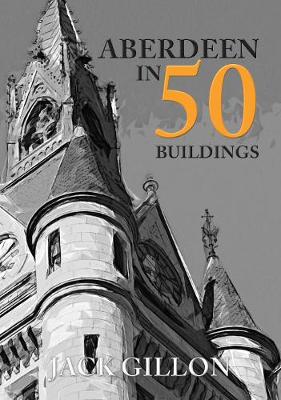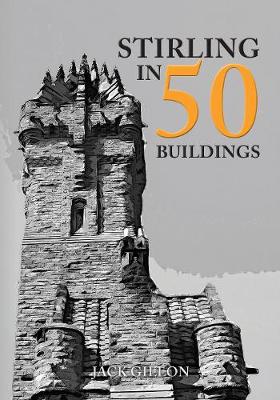In 50 Buildings
3 total works
Aberdeen, Scotland's third largest city, has been a place of economic importance since the development of the shipbuilding and fishing industries, and has been synonymous with oil ever since the discovery of North Sea reserves in the 1970s. Nicknamed the 'Granite City' due to the locally quarried grey granite that was used in many of the city's most important buildings, Aberdeen has a proud and distinctive identity with an extraordinary history embodied in the many fine buildings that have shaped the city.
Aberdeen in 50 Buildings explores the history of this rich and vibrant city through a selection of its greatest architectural assets, from notable buildings such as the Music Hall, the Trinity Hall, the new Town House and, of course, Alexander Marshall Mackenzie's extension to Marischal College, the second largest granite building in the world, to more recent additions such as the Maggie's Centre and the Sir Duncan Rice Library. Aberdeen in 50 Buildingsguides the reader on a tour of Aberdeen's historic buildings and modern architectural marvels to celebrate the city's architectural heritage in a new and accessible way.
Aberdeen in 50 Buildings explores the history of this rich and vibrant city through a selection of its greatest architectural assets, from notable buildings such as the Music Hall, the Trinity Hall, the new Town House and, of course, Alexander Marshall Mackenzie's extension to Marischal College, the second largest granite building in the world, to more recent additions such as the Maggie's Centre and the Sir Duncan Rice Library. Aberdeen in 50 Buildingsguides the reader on a tour of Aberdeen's historic buildings and modern architectural marvels to celebrate the city's architectural heritage in a new and accessible way.
From its founding as a Royal Burgh in the twelfth century and through its growth and development as an internationally renowned hotbed of science, education, literature and culture, to its current status as home of the Scottish Parliament and the largest financial centre in the UK outside London, Edinburgh has a proud and distinctive identity. This extraordinary history is embodied in the many fine buildings that have shaped the 'Athens of the North'.
Edinburgh in 50 Buildings explores the history of this rich and vibrant city through a selection of its greatest architectural treasures. From the elegance of the neoclassical and Georgian New Town to the controversial Parliament building, this unique study celebrates the city's architectural heritage in a new and accessible way. Local author Jack Gillon guides the reader on a tour of the city's historic buildings and modern architectural marvels.
Edinburgh in 50 Buildings explores the history of this rich and vibrant city through a selection of its greatest architectural treasures. From the elegance of the neoclassical and Georgian New Town to the controversial Parliament building, this unique study celebrates the city's architectural heritage in a new and accessible way. Local author Jack Gillon guides the reader on a tour of the city's historic buildings and modern architectural marvels.
Having been granted city status during the Golden Jubilee celebrations in 2002, Stirling is Scotland's smallest city, with an enthralling wealth of architectural heritage and history that would be the envy of much larger places in the country. Stirling's heritage dates from the thirteenth century, when it was granted a royal charter and became a significant medieval settlement. Its strategic importance as the 'Gateway to the Highlands' also made it the much fought over 'Cockpit of Scotland' and it has witnessed many of the most significant battles in Scottish history. In this book, author Jack Gillon takes the reader on a tour of fifty of the city's finest buildings and structures, celebrating its immense architectural heritage and ancient character.
Stirling's military prominence is reflected by its imposing castle, which has served as both a fortress and royal residence over the centuries - Mary, Queen of Scots was crowned there in 1543. The author also highlights the city's places of worship including the Church of the Holy Rude and the ruined twelfth-century Cambuskenneth Abbey. Other treasures include The Atheneum, dating from the early nineteenth century; the Stirling Smith Art Gallery; and the city's many historic houses; while past and present combine at the Battle of Bannockburn Centre. Also featured are the memorials and monuments to notable figures such as Robert the Bruce and Sir William Wallace.
Stirling in 50 Buildings provides a fascinating exploration of this charming historic city that will appeal to residents and visitors alike.
Stirling's military prominence is reflected by its imposing castle, which has served as both a fortress and royal residence over the centuries - Mary, Queen of Scots was crowned there in 1543. The author also highlights the city's places of worship including the Church of the Holy Rude and the ruined twelfth-century Cambuskenneth Abbey. Other treasures include The Atheneum, dating from the early nineteenth century; the Stirling Smith Art Gallery; and the city's many historic houses; while past and present combine at the Battle of Bannockburn Centre. Also featured are the memorials and monuments to notable figures such as Robert the Bruce and Sir William Wallace.
Stirling in 50 Buildings provides a fascinating exploration of this charming historic city that will appeal to residents and visitors alike.


